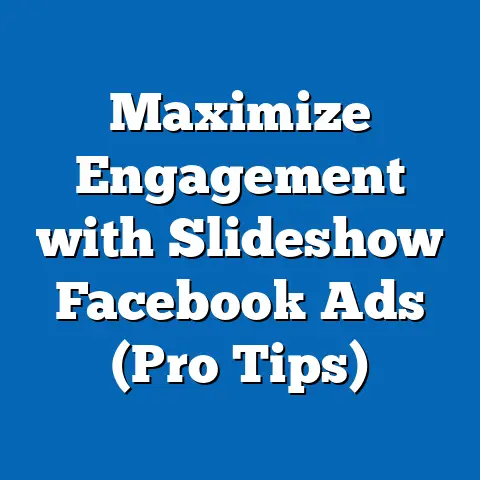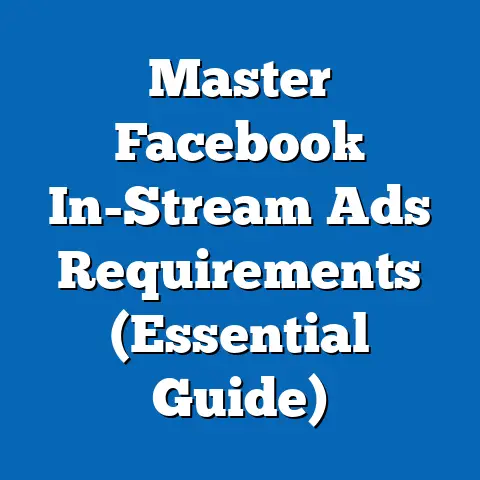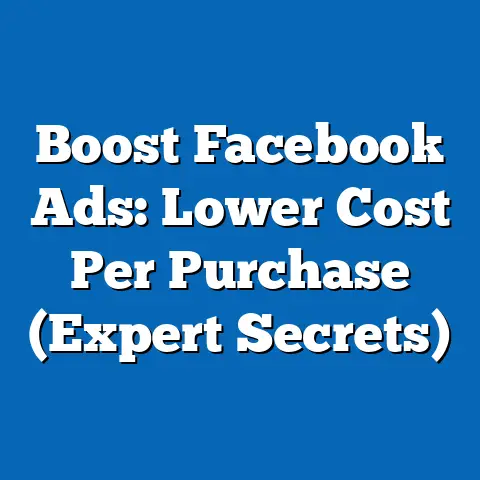Leverage Others’ Videos in Facebook Ads (Legal Insights)
Video is king. That’s not just a catchy phrase; it’s a reality in today’s digital landscape. As of 2023, video content is projected to account for a staggering 82% of all consumer internet traffic, according to a report by Cisco. On platforms like Facebook, where I’ve personally seen the power of video firsthand, engagement rates for video ads significantly outperform static ads. But here’s the rub: while leveraging existing video content can supercharge your ad effectiveness, it also opens a Pandora’s Box of legal implications.
I remember working with a small e-commerce brand a few years back. They found a viral video of someone unboxing their product and wanted to use it in an ad. It seemed like a brilliant move – instant social proof! However, they hadn’t secured permission from the video creator. The result? A cease-and-desist letter and a hefty legal bill. That experience taught me a valuable lesson: creativity without compliance can be a costly mistake.
1. Understanding Copyright in the Digital Age
Copyright is the bedrock of content ownership in the digital world. It’s a legal right granted to creators of original works, including videos, protecting their exclusive rights to reproduce, distribute, display, and create derivative works from their creations. Think of it as a shield that safeguards a creator’s intellectual property.
Why is copyright important in the context of Facebook ads? Simply put, using someone else’s video in your ad without permission is a direct violation of their copyright. It’s akin to walking into someone’s store and taking their merchandise without paying. The consequences can range from a takedown notice from Facebook to a full-blown lawsuit.
The “Fair Use” Exception: A Narrow Escape Hatch
Now, there’s a glimmer of hope for those looking to use copyrighted material: the concept of “fair use.” Fair use allows limited use of copyrighted material without permission from the copyright holder for purposes such as criticism, commentary, news reporting, teaching, scholarship, and research. However, fair use is not a free pass; it’s a highly nuanced and fact-specific defense.
Determining whether a particular use qualifies as fair use involves a careful balancing of four factors, as outlined by the Copyright Act:
- The purpose and character of the use, including whether such use is of a commercial nature or is for nonprofit educational purposes: Is your use transformative? Are you adding new meaning or expression to the original work, or are you simply copying it for commercial gain? Commercial use weighs against fair use.
- The nature of the copyrighted work: Is the work factual or creative? Using factual works is more likely to be considered fair use than using highly creative works.
- The amount and substantiality of the portion used in relation to the copyrighted work as a whole: Are you using only a small portion of the video, or are you using the entire thing? Using a small, non-essential portion is more likely to be considered fair use.
- The effect of the use upon the potential market for or value of the copyrighted work: Does your use harm the market for the original work? Are you depriving the copyright holder of potential revenue? If so, it weighs against fair use.
Example: Imagine you’re running a Facebook ad for a film review website. You include a 5-second clip from a popular movie to illustrate your point. This might qualify as fair use, as your purpose is commentary and criticism, you’re using a small portion of the work, and your use likely doesn’t harm the movie’s market. However, if you use a significant portion of the movie to entice viewers to your site, it’s less likely to be considered fair use.
Copyright and User-Generated Content (UGC) on Facebook
The rise of social media has blurred the lines of copyright ownership. What happens when a user creates a video and posts it on Facebook? Does Facebook own the copyright? Does the user? The answer is generally the latter. Users typically retain copyright ownership of the content they create and post on Facebook, subject to Facebook’s terms of service.
This means that even if a video is publicly available on Facebook, you still need permission from the creator to use it in your ads. Simply finding a video online doesn’t give you the right to use it commercially.
Legal Cases: Lessons from the Courtroom
Numerous legal cases have highlighted the importance of respecting video copyright. One notable example is the case of Perfect 10, Inc. v. Amazon.com, Inc., which involved the use of copyrighted images in Google’s search results. While not directly related to video, it established important principles regarding copyright infringement and the responsibilities of online platforms.
Another relevant case is Viacom International Inc. v. YouTube, Inc., which addressed the issue of copyright infringement on YouTube. While YouTube ultimately prevailed in the lawsuit, it highlighted the importance of having systems in place to address copyright infringement claims.
These cases underscore the potential consequences of using videos without permission. Businesses that engage in copyright infringement can face significant financial penalties, reputational damage, and legal battles.
Key Takeaway: Copyright is a fundamental legal right that protects video creators. While fair use provides a limited exception, it’s crucial to understand its limitations. Always obtain permission from the copyright holder before using a video in your Facebook ads.
Next Steps: Familiarize yourself with the Copyright Act and consult with an attorney if you have any questions about copyright law. Implement a process for verifying copyright ownership before using any video in your ads.
2. Types of Video Content and Ownership
Not all video content is created equal, and understanding the different types of video content and their associated ownership rights is crucial for navigating the legal landscape of Facebook advertising. Here’s a breakdown of the most common types:
1. Original Content:
- Definition: Videos created by you or your company. This includes videos shot with your own equipment, animations you’ve created, and videos produced by a hired production team.
- Ownership: You or your company own the copyright to the video.
- Considerations: Ensure you have written agreements with any actors, musicians, or other contributors involved in the creation of the video to clarify ownership and usage rights.
2. User-Generated Content (UGC):
- Definition: Videos created by users or customers, often featuring your product or service. This can include product reviews, testimonials, unboxing videos, and social media posts.
- Ownership: The user who created the video typically owns the copyright.
- Considerations: You must obtain explicit permission from the user to use their video in your Facebook ads. Simply reposting the video without permission is copyright infringement.
3. Stock Footage:
- Definition: Pre-made video clips that can be licensed for commercial use. These clips are often available on stock footage websites like Shutterstock, Getty Images, and Pond5.
- Ownership: The stock footage agency or the videographer who created the footage owns the copyright.
- Considerations: You must purchase a license to use stock footage in your ads. The license agreement will specify the permitted uses, such as commercial advertising.
4. Public Domain Videos:
- Definition: Videos that are not protected by copyright and are free for anyone to use. This can include videos that are in the public domain due to their age or because the copyright holder has relinquished their rights.
- Ownership: No one owns the copyright to public domain videos.
- Considerations: While public domain videos are free to use, it’s important to verify their public domain status to avoid potential copyright issues.
5. Creative Commons Videos:
- Definition: Videos licensed under Creative Commons licenses, which allow for certain uses of the work with attribution.
- Ownership: The copyright holder retains ownership, but grants specific permissions for use.
- Considerations: Carefully review the terms of the Creative Commons license to ensure your intended use is permitted. Attribution is almost always required.
Licensing and Permissions: Your Legal Lifeline
The key to legally using videos created by others is obtaining the necessary licenses and permissions. A license is a legal agreement that grants you the right to use a copyrighted work in a specific way. Permissions are similar to licenses, but they may be less formal and may not involve a written agreement.
How to Obtain Licenses and Permissions:
- Contact the Copyright Holder: The best way to obtain permission is to directly contact the copyright holder and ask for permission to use their video. Be clear about how you intend to use the video and what rights you need.
- Use a Licensing Platform: Several platforms specialize in licensing video content for commercial use. These platforms make it easy to find and license videos from a variety of creators.
- Review the Terms of Service: If you’re using a video from a social media platform, review the platform’s terms of service to understand your rights and obligations.
Platforms for Licensed Video Content:
- Shutterstock: Offers a vast library of stock footage with various licensing options.
- Getty Images: Another popular source for high-quality stock footage.
- Pond5: Specializes in royalty-free stock footage and other media assets.
- Storyblocks: Provides unlimited access to stock footage, audio, and templates for a subscription fee.
Navigating Licensing Options Effectively:
- Understand the Different License Types: Stock footage agencies typically offer different license types, such as standard licenses and extended licenses. Standard licenses are suitable for most advertising uses, while extended licenses may be required for high-volume campaigns or certain types of distribution.
- Read the Fine Print: Carefully review the terms of the license agreement before using the video. Pay attention to restrictions on usage, such as limitations on the number of impressions or the geographic region where the ad can be displayed.
- Keep Records: Maintain records of all licenses and permissions you obtain, including the date of the agreement, the name of the copyright holder, and the terms of the license.
Key Takeaway: Understanding the different types of video content and their associated ownership rights is essential for avoiding copyright infringement. Always obtain the necessary licenses and permissions before using a video created by someone else.
Next Steps: Create a checklist for verifying video ownership before using any video in your Facebook ads. Research and identify platforms that offer licensed video content that meets your needs.
3. Navigating Facebook’s Policies on Video Content
Facebook, now Meta, has a vested interest in protecting intellectual property rights on its platform. Their advertising policies are designed to prevent copyright infringement and ensure that users are not exposed to unauthorized content. Understanding these policies is crucial for businesses that want to use video content in their Facebook ads.
Overview of Facebook’s Advertising Policies:
Facebook’s advertising policies prohibit the use of content that infringes upon the intellectual property rights of others. This includes videos, music, images, and other copyrighted materials. Specifically, Facebook states that ads must not:
- Infringe upon or violate the rights of any third party, including copyright, trademark, privacy, or other personal or proprietary rights.
- Contain content that is misleading, deceptive, or fraudulent.
- Promote illegal activities or products.
Implications of Facebook’s Policies on Copyright Infringement:
If you violate Facebook’s advertising policies, your ad may be disapproved, your ad account may be suspended, or your Facebook page may be banned. In severe cases, Facebook may even take legal action against you.
Facebook’s policies also state that they may remove or disable access to content that is reported to infringe upon copyright. This means that if a copyright holder believes that your ad contains infringing content, they can report it to Facebook, and Facebook may remove the ad.
Ensuring Compliance with Facebook’s Policies:
To ensure compliance with Facebook’s advertising policies, follow these guidelines:
- Obtain Permission: Always obtain permission from the copyright holder before using a video in your Facebook ad.
- Use Licensed Content: Use stock footage or other licensed video content from reputable sources.
- Review Facebook’s Advertising Policies: Regularly review Facebook’s advertising policies to stay up-to-date on the latest requirements.
- Monitor Your Ads: Monitor your ads for copyright infringement claims and respond promptly to any notifications from Facebook.
Reporting Copyright Infringement on Facebook:
Facebook provides a mechanism for copyright holders to report infringing content. If you believe that your copyright has been infringed upon by a Facebook ad, you can submit a copyright infringement claim through Facebook’s online form.
The Role of Content ID Systems:
Facebook uses Content ID systems to help protect creators’ rights. These systems automatically scan uploaded videos for copyrighted material and compare them to a database of copyrighted works. If a match is found, the copyright holder can choose to:
- Monetize the video: Allow the video to remain on Facebook and earn revenue from it.
- Track the video: Monitor the video’s performance and gather data about its viewership.
- Block the video: Remove the video from Facebook.
Case Studies: Learning from Others’ Mistakes
Several businesses have faced penalties for violating Facebook’s video policies. One example involves a company that used a popular song in their Facebook ad without obtaining a license. The copyright holder reported the ad to Facebook, and Facebook removed the ad and suspended the company’s ad account.
Another example involves a company that used a user-generated video in their Facebook ad without obtaining permission from the user. The user complained to Facebook, and Facebook removed the ad and issued a warning to the company.
Lessons Learned:
- Copyright infringement is a serious issue: Facebook takes copyright infringement seriously and will take action against businesses that violate its policies.
- It’s always better to ask for permission: Don’t assume that you have the right to use a video simply because it’s publicly available on Facebook.
- Stay informed: Keep up-to-date on Facebook’s advertising policies and copyright laws.
Key Takeaway: Facebook’s advertising policies prohibit the use of content that infringes upon the intellectual property rights of others. Businesses must ensure compliance with these policies to avoid penalties.
Next Steps: Familiarize yourself with Facebook’s advertising policies and copyright laws. Implement a process for verifying copyright ownership before using any video in your Facebook ads.
4. Best Practices for Legally Using Others’ Videos in Facebook Ads
Now that we’ve covered the legal groundwork, let’s dive into practical strategies for legally incorporating other people’s videos into your Facebook ad campaigns. The goal is to create engaging and effective ads while respecting copyright laws and avoiding potential legal headaches.
Sourcing Video Content Legally:
- Obtain Explicit Permission from Creators: This is the gold standard. If you want to use a user-generated video or any other video created by someone else, reach out to the creator and ask for their permission. Be transparent about how you intend to use the video and what rights you need.
- Use Licensed Content: Stock footage websites and other licensing platforms offer a wide variety of videos that you can license for commercial use. Be sure to choose a license that covers your intended use.
- Explore Creative Commons Licenses: Creative Commons licenses allow for certain uses of copyrighted works with attribution. Review the terms of the license carefully to ensure your intended use is permitted.
- Consider Public Domain Videos: Public domain videos are free to use without permission. However, verify their public domain status to avoid potential copyright issues.
Contracts and Agreements: Protecting Your Business
When collaborating with video creators, it’s essential to have a written contract or agreement that clearly outlines the terms of the relationship. This will protect your business from potential legal disputes and ensure that everyone is on the same page.
Key Elements to Include in a Video Collaboration Agreement:
- Scope of Work: Clearly define the scope of work, including the type of video to be created, the length of the video, and the delivery date.
- Ownership of Copyright: Specify who owns the copyright to the video. In most cases, the creator will retain ownership, but you may want to negotiate for ownership or a perpetual license to use the video.
- Usage Rights: Clearly define how you are allowed to use the video. This should include the platforms where you can use the video, the duration of the license, and any restrictions on usage.
- Payment Terms: Specify the payment terms, including the amount to be paid, the payment schedule, and any expenses that will be reimbursed.
- Liability and Indemnification: Include provisions that protect your business from liability in the event of a copyright infringement claim or other legal dispute.
Checklist for Using Others’ Videos in Facebook Ads:
Before using any video in your Facebook ad, ask yourself the following questions:
- Who owns the copyright to the video?
- Have I obtained permission from the copyright holder to use the video in my ad?
- If I’m using stock footage, do I have a valid license that covers my intended use?
- Have I reviewed the terms of service of the platform where I found the video?
- Am I complying with Facebook’s advertising policies?
Creative Ways to Incorporate UGC While Respecting Copyright:
- Feature Testimonials and Reviews: Instead of using entire user-generated videos, consider featuring short snippets of testimonials or reviews in your ads.
- Create a Compilation Video: Compile multiple short clips of user-generated videos into a single ad.
- Ask Users to Submit Videos: Run a contest or promotion where users submit videos featuring your product or service. Be sure to obtain permission to use the videos in your ads.
Example: A beauty brand could run a contest asking customers to submit videos showcasing their makeup looks using the brand’s products. The brand could then select the best videos and feature them in their Facebook ads, with permission from the creators.
Key Takeaway: Legally using others’ videos in Facebook ads requires careful planning and attention to detail. Obtain permission, use licensed content, and have written agreements in place to protect your business.
Next Steps: Develop a standard contract template for video collaborations. Create a checklist for verifying video ownership before using any video in your Facebook ads.
5. Future Trends in Video Content and Advertising
The world of video content and advertising is constantly evolving. Understanding the latest trends and anticipating future developments is crucial for staying ahead of the curve and maximizing the effectiveness of your Facebook ad campaigns.
Current Trends in Video Content Creation and Consumption on Facebook:
- Rise of Short-Form Videos: Short-form videos, such as Reels and TikTok-style videos, are becoming increasingly popular on Facebook. These videos are engaging, easy to consume, and perfect for mobile devices.
- Live Streaming: Live streaming is another growing trend on Facebook. Live videos allow businesses to connect with their audience in real-time and build a sense of community.
- Interactive Videos: Interactive videos, such as quizzes and polls, are becoming more common on Facebook. These videos encourage engagement and provide valuable data about your audience.
- Personalized Videos: Personalized videos, which are tailored to individual users based on their interests and preferences, are becoming more sophisticated. These videos can significantly improve ad performance.
Impact of Evolving Copyright Laws:
Copyright laws are constantly evolving to keep pace with technological advancements. In the coming years, we can expect to see further developments in copyright law that impact the use of video content in advertising.
- Increased Enforcement of Copyright Laws: Copyright holders are becoming more aggressive in enforcing their rights, and online platforms are under increasing pressure to combat copyright infringement.
- Development of New Licensing Models: New licensing models are emerging that make it easier for businesses to obtain the rights they need to use video content legally.
- Increased Use of Artificial Intelligence (AI) in Copyright Detection: AI is being used to develop more sophisticated tools for detecting copyright infringement.
Role of Artificial Intelligence (AI) and Technology in Content Creation:
AI is revolutionizing the way video content is created. AI-powered tools can now generate videos automatically, create realistic avatars, and even write scripts.
- AI-Generated Videos: AI-generated videos are becoming increasingly realistic and sophisticated. These videos can be used for a variety of purposes, such as product demos, explainer videos, and social media ads.
- Virtual Influencers: Virtual influencers, which are computer-generated characters that have a large following on social media, are becoming more popular. These influencers can be used to promote products and services.
- Automated Video Editing: AI-powered video editing tools can automate many of the tasks involved in video editing, such as cutting clips, adding transitions, and color correcting.
Potential for New Platforms and Tools for Legal Video Sharing:
As the demand for video content continues to grow, we can expect to see the emergence of new platforms and tools that facilitate legal video sharing for advertising purposes.
- Blockchain-Based Licensing Platforms: Blockchain technology can be used to create secure and transparent licensing platforms that make it easier for businesses to obtain the rights they need to use video content legally.
- AI-Powered Copyright Clearance Tools: AI can be used to develop tools that automatically identify and clear copyrighted material in videos.
- Decentralized Video Sharing Platforms: Decentralized video sharing platforms can give creators more control over their content and allow them to monetize their videos directly.
Key Takeaway: The future of video content and advertising is bright, but it’s important to stay informed about the latest trends and developments. Embrace new technologies and platforms, but always respect copyright laws and protect your business from potential legal risks.
Next Steps: Research AI-powered video creation tools. Explore blockchain-based licensing platforms. Monitor developments in copyright law and online advertising.
Conclusion
Navigating the legal landscape of leveraging others’ videos in Facebook ads can feel like traversing a minefield. However, with a solid understanding of copyright law, different types of video content, Facebook’s policies, and best practices for legal usage, you can confidently harness the power of video advertising without risking legal trouble.
Throughout this article, we’ve explored the essential elements of responsible video advertising. We’ve defined copyright and its relevance to digital content, examined the “fair use” exception, and discussed the importance of obtaining licenses and permissions. We’ve also delved into Facebook’s advertising policies and the role of Content ID systems in protecting creators’ rights.
The key takeaway is this: creativity and compliance must go hand in hand. You can’t afford to ignore the legal aspects of using video content in your Facebook ads. Doing so can result in costly lawsuits, reputational damage, and the suspension of your ad account.
As the digital advertising landscape continues to evolve, video content will play an increasingly important role in shaping marketing strategies. By embracing video advertising while remaining within legal boundaries, you can unlock new opportunities to connect with your audience, build your brand, and drive business growth.
So, go forth and create compelling video ads that capture attention and drive results. But remember to always prioritize copyright compliance and respect the rights of video creators. With a little bit of knowledge and careful planning, you can leverage the power of video advertising to achieve your marketing goals without risking legal repercussions. The future of marketing is visual, and it’s up to us to navigate it responsibly and ethically.






